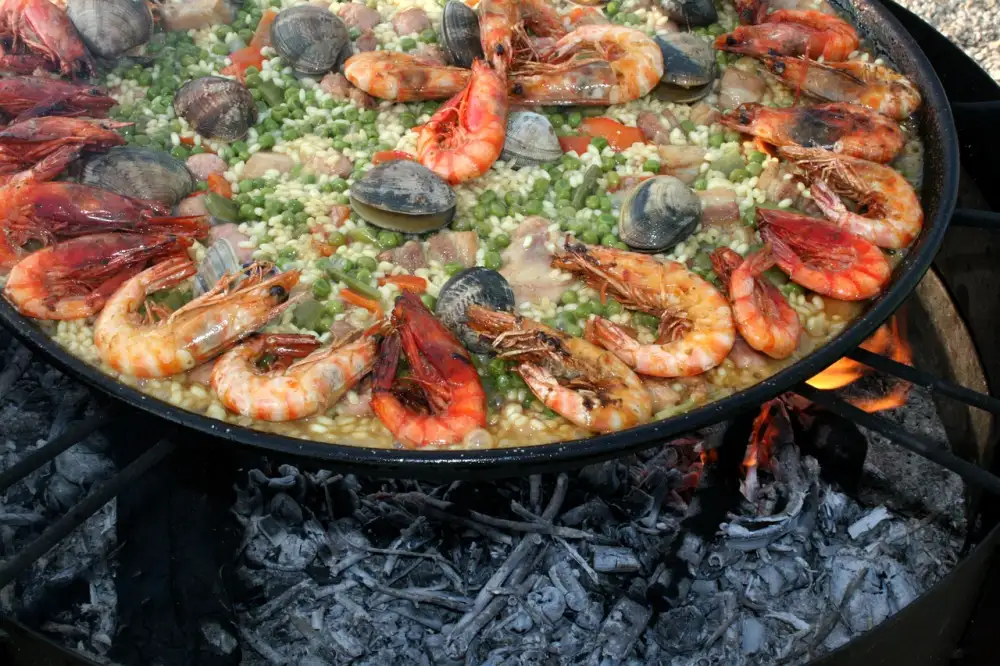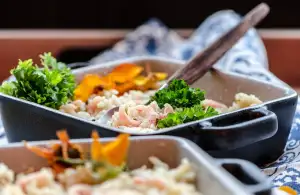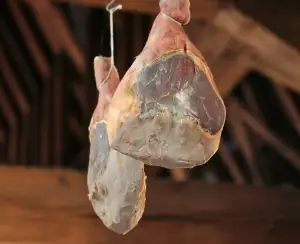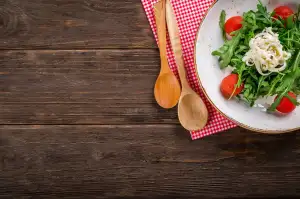Valencian Paella: Unveiling the Authentic Recipe for this Spanish Culinary Delight

- Introduction to Valencian Paella
- History and Origins of Valencian Paella
- Traditional Ingredients Used in Valencian Paella
- Step-by-Step Guide to Cooking Valencian Paella
- Tips and Tricks for Perfecting Valencian Paella
- Variations and Adaptations of Valencian Paella
- Serving and Enjoying Valencian Paella
- Conclusion: Valencian Paella - A Taste of Spain's Culinary Heritage
Introduction to Valencian Paella
Valencian Paella is a renowned Spanish dish that has captivated taste buds around the world. Hailing from the region of Valencia, this culinary masterpiece is a true representation of Spain's rich gastronomic heritage. With its vibrant colors, tantalizing aromas, and exquisite flavors, Valencian Paella offers a sensory experience like no other. Join us as we delve into the secrets behind this iconic dish and uncover the authentic recipe that has been passed down through generations. Prepare to embark on a culinary journey that will leave you craving for more!
History and Origins of Valencian Paella
Valencian paella, a beloved Spanish dish, has a rich history and fascinating origins. Its roots can be traced back to the 18th century in the region of Valencia, located on the eastern coast of Spain. Originally, paella was a simple and hearty meal prepared by farmers and laborers in the countryside.
The word "paella" actually refers to the shallow pan in which this dish is cooked. The name itself comes from the Latin word "patella," meaning pan. In its early days, Valencian paella was made with ingredients that were readily available in the region - rice, vegetables, and meat such as rabbit or chicken.
Over time, as trade routes expanded and Valencia became an important port city, new ingredients like saffron and beans were introduced to the dish. Saffron not only added vibrant color but also imparted a distinct flavor to the rice. The addition of beans gave Valencian paella its signature touch.
In the mid-19th century, Valencian paella gained popularity beyond its rural origins. It became a symbol of regional identity and pride for Valencians. As tourism grew in Spain during the 20th century, so did the fame of this iconic dish. Today, it is recognized worldwide as one of Spain's most cherished culinary treasures.
Valencian paella has remained true to its traditional roots throughout history. It continues to be prepared using local ingredients sourced from Valencia's fertile lands. The cooking techniques have been passed down through generations, ensuring that each plate captures the essence of authentic Valencian cuisine.
The history and origins of Valencian paella are not just a tale of food but also reflect the cultural heritage and traditions of Valencia. This iconic dish represents the simplicity and resourcefulness of rural life while showcasing the flavors that make Spanish cuisine so exceptional.
Traditional Ingredients Used in Valencian Paella
Valencian paella is known for its simplicity and use of fresh, local ingredients. The key components include short-grain rice, saffron, olive oil, chicken or rabbit, green beans, and white beans. These ingredients come together to create a harmonious blend of flavors and textures. The rice absorbs the rich flavors of the meat and vegetables while the saffron adds a vibrant yellow color and distinct aroma. The use of olive oil enhances the overall taste and provides a silky texture to the dish. It is important to source high-quality ingredients to ensure an authentic and delicious Valencian paella experience.
Step-by-Step Guide to Cooking Valencian Paella
Step-by-Step Guide to Cooking Valencian Paella:
1. Start by heating olive oil in a large paella pan over medium heat.
2. Add diced onions and sauté until they become translucent.
3. Next, add chopped garlic and cook for a minute until fragrant.
4. Add the meat of your choice, such as chicken or rabbit, and cook until browned.
5. Stir in the vegetables like green beans and bell peppers, and cook for a few minutes.
6. Sprinkle generous amounts of sweet paprika and saffron threads into the pan for flavor and color.
7. Pour in the bomba rice evenly across the pan, stirring it gently to coat with oil and spices.
8. Slowly pour in the simmering broth or stock, making sure it covers the rice completely.
9. Arrange the seafood, like prawns or mussels, on top of the rice mixture.
10. Let it simmer uncovered for about 15-20 minutes until most of the liquid is absorbed.
11. Once cooked, remove from heat and cover with a clean kitchen towel for a few minutes to let it rest.
12. Serve hot directly from the pan, garnished with lemon wedges.
Follow these steps carefully to create an authentic Valencian Paella that will impress your guests with its rich flavors and vibrant colors!
Tips and Tricks for Perfecting Valencian Paella
Tips and Tricks for Perfecting Valencian Paella:
1. Use the right rice: The key to a perfect Valencian paella lies in using the correct type of rice. Short-grain varieties like Bomba or Calasparra are ideal as they absorb the flavors without becoming mushy.
2. Sauté the ingredients: Before adding the rice, sauté the vegetables and meat in olive oil to enhance their flavors. This step adds depth to your paella.
3. Maintain the socarrat: Socarrat refers to the crispy layer of rice that forms at the bottom of the pan. To achieve this, let the paella cook undisturbed on low heat towards the end, ensuring a delicious caramelized crust.
4. Balance seasoning: Valencian paella is traditionally seasoned with saffron, paprika, and salt. Be mindful of not overpowering these delicate flavors; adjust seasoning gradually and taste as you go.
5. Control heat and liquid: Keep an eye on your cooking temperature and add broth gradually throughout the cooking process. This helps prevent overcooking or drying out of the rice.
6. Rest before serving: Allow your Valencian paella to rest for a few minutes after cooking. This allows the flavors to meld together and ensures a more enjoyable dining experience.
By following these tips, you can master the art of preparing an authentic Valencian paella that will impress your guests and transport them to Spain's culinary paradise.
Variations and Adaptations of Valencian Paella
While the traditional Valencian paella recipe remains the most authentic and beloved, there have been some variations and adaptations over time. These adaptations often reflect regional preferences or the availability of ingredients. One popular variation is seafood paella, which includes a medley of fresh seafood such as shrimp, mussels, and clams. Another adaptation is mixed paella, which combines both meat (such as chicken and rabbit) and seafood.
Vegetarian paella is also a delicious option for those who prefer plant-based dishes. It replaces meat and seafood with an assortment of vegetables like artichokes, bell peppers, green beans, and tomatoes. This version still captures the essence of Valencian paella while catering to different dietary choices.
In recent years, chefs have experimented with fusion versions of Valencian paella by incorporating ingredients from other cuisines. For example, you may find paella with chorizo or saffron-infused rice topped with Asian-inspired flavors like soy sauce or ginger.
It's important to note that while these adaptations can be enjoyable in their own right, they should not be confused with the traditional Valencian paella recipe. The original recipe holds a special place in Spanish culinary heritage and continues to be cherished by locals and visitors alike.
Whether you choose to stick to tradition or explore these variations, one thing remains certain - Valencian paella is a versatile dish that can be adapted to suit various tastes and preferences without losing its essence.
Serving and Enjoying Valencian Paella
Once your Valencian paella is cooked to perfection, it's time to serve and enjoy this Spanish culinary delight. The traditional way to serve paella is straight from the pan, allowing everyone to dig in and savor the flavors together.
Remember to let the paella rest for a few minutes before serving. This allows the flavors to meld together and ensures that each bite is packed with deliciousness. Garnish with freshly chopped parsley for a pop of color and freshness.
Valencian paella is often enjoyed with a side of aioli, a garlic-infused mayonnaise. The creamy aioli complements the rich flavors of the paella and adds an extra layer of decadence.
To truly appreciate Valencian paella, gather your friends and family around the table. Share stories, laughter, and good company as you indulge in this iconic dish. Pair it with a glass of sangria or a crisp white wine for a complete sensory experience.
Don't forget to scrape the bottom of the pan for those crispy bits known as "socarrat." These caramelized rice pieces are highly prized in Valencian cuisine and add an irresistible texture to each spoonful.
Whether you're enjoying Valencian paella at a restaurant in Valencia or recreating it at home, take your time to savor each bite. Let the flavors transport you to sunny Spain as you relish in this culinary masterpiece that has stood the test of time.
Conclusion: Valencian Paella - A Taste of Spain's Culinary Heritage
Valencian Paella is not just a dish; it is a representation of Spain's rich culinary heritage. Its origins dating back to the 18th century, this iconic rice dish has become synonymous with Spanish cuisine. The combination of fresh ingredients, traditional cooking techniques, and the unique flavor profile make Valencian Paella a true delight for the senses.
The careful selection of ingredients, such as Bomba rice, saffron, and local vegetables, ensures that each bite is bursting with authentic flavors. The methodical preparation process, from sautéing the sofrito to patiently simmering the rice to perfection in a wide pan known as a paellera, showcases the dedication and craftsmanship behind this beloved dish.
While there may be variations and adaptations of Valencian Paella across different regions and countries, it is important to honor the original recipe and respect its cultural significance. Valencian Paella is not just about the taste; it represents a way of life, bringing people together around a shared table to savor every spoonful.
Whether enjoyed at a lively family gathering or in a quaint seaside restaurant overlooking the Mediterranean, Valencian Paella offers an immersive experience into Spanish culture. It captures the essence of Spain's love for food, community, and celebration.
So next time you find yourself craving an authentic taste of Spain, venture into the world of Valencian Paella. Immerse yourself in its history and tradition while savoring every flavorful bite. Discover why this iconic dish has captured hearts around the world and why it continues to be cherished as one of Spain's greatest culinary treasures.
Published: 13. 11. 2023
Category: Recipes



